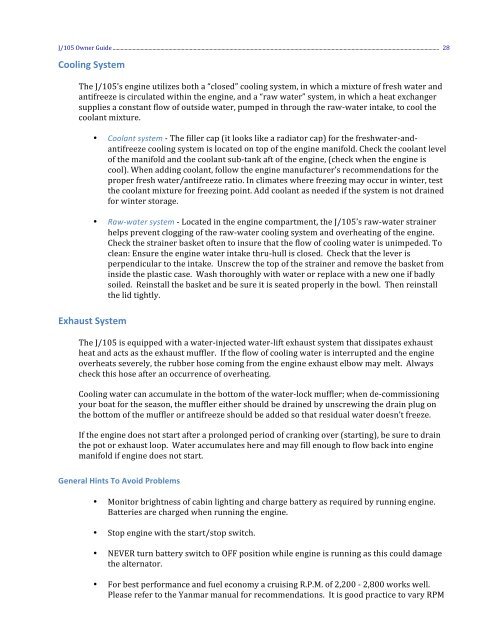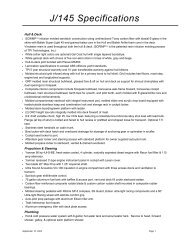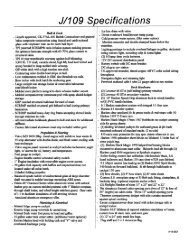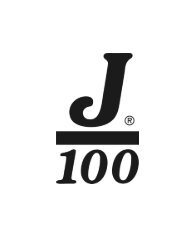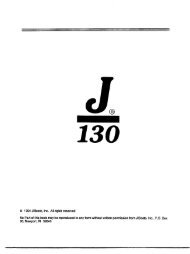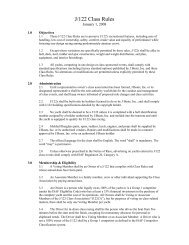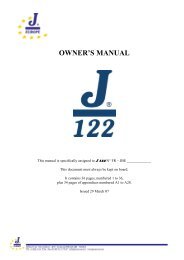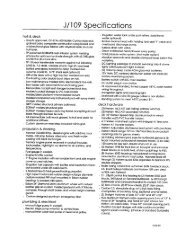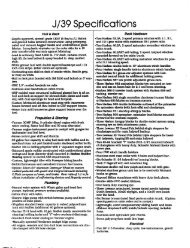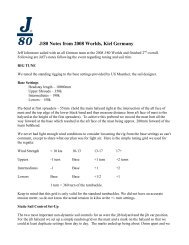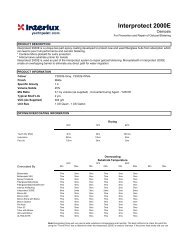J105 Owner Manual 2012.pdf - J/Owners
J105 Owner Manual 2012.pdf - J/Owners
J105 Owner Manual 2012.pdf - J/Owners
You also want an ePaper? Increase the reach of your titles
YUMPU automatically turns print PDFs into web optimized ePapers that Google loves.
J/105 <strong>Owner</strong> Guide ...................................................................................................................................................................................................................................................... 28 <br />
Cooling System <br />
The J/105’s engine utilizes both a “closed” cooling system, in which a mixture of fresh water and <br />
antifreeze is circulated within the engine, and a “raw water” system, in which a heat exchanger <br />
supplies a constant flow of outside water, pumped in through the raw-‐water intake, to cool the <br />
coolant mixture. <br />
• Coolant system -‐ The filler cap (it looks like a radiator cap) for the freshwater-‐and-antifreeze<br />
cooling system is located on top of the engine manifold. Check the coolant level <br />
of the manifold and the coolant sub-‐tank aft of the engine, (check when the engine is <br />
cool). When adding coolant, follow the engine manufacturer’s recommendations for the <br />
proper fresh water/antifreeze ratio. In climates where freezing may occur in winter, test <br />
the coolant mixture for freezing point. Add coolant as needed if the system is not drained <br />
for winter storage. <br />
• Raw-‐water system -‐ Located in the engine compartment, the J/105’s raw-‐water strainer <br />
helps prevent clogging of the raw-‐water cooling system and overheating of the engine. <br />
Check the strainer basket often to insure that the flow of cooling water is unimpeded. To <br />
clean: Ensure the engine water intake thru-‐hull is closed. Check that the lever is <br />
perpendicular to the intake. Unscrew the top of the strainer and remove the basket from <br />
inside the plastic case. Wash thoroughly with water or replace with a new one if badly <br />
soiled. Reinstall the basket and be sure it is seated properly in the bowl. Then reinstall <br />
the lid tightly. <br />
Exhaust System <br />
The J/105 is equipped with a water-‐injected water-‐lift exhaust system that dissipates exhaust <br />
heat and acts as the exhaust muffler. If the flow of cooling water is interrupted and the engine <br />
overheats severely, the rubber hose coming from the engine exhaust elbow may melt. Always <br />
check this hose after an occurrence of overheating. <br />
Cooling water can accumulate in the bottom of the water-‐lock muffler; when de-‐commissioning <br />
your boat for the season, the muffler either should be drained by unscrewing the drain plug on <br />
the bottom of the muffler or antifreeze should be added so that residual water doesn’t freeze. <br />
If the engine does not start after a prolonged period of cranking over (starting), be sure to drain <br />
the pot or exhaust loop. Water accumulates here and may fill enough to flow back into engine <br />
manifold if engine does not start. <br />
General Hints To Avoid Problems <br />
• Monitor brightness of cabin lighting and charge battery as required by running engine. <br />
Batteries are charged when running the engine. <br />
• Stop engine with the start/stop switch. <br />
• NEVER turn battery switch to OFF position while engine is running as this could damage <br />
the alternator. <br />
• For best performance and fuel economy a cruising R.P.M. of 2,200 -‐ 2,800 works well. <br />
Please refer to the Yanmar manual for recommendations. It is good practice to vary RPM


